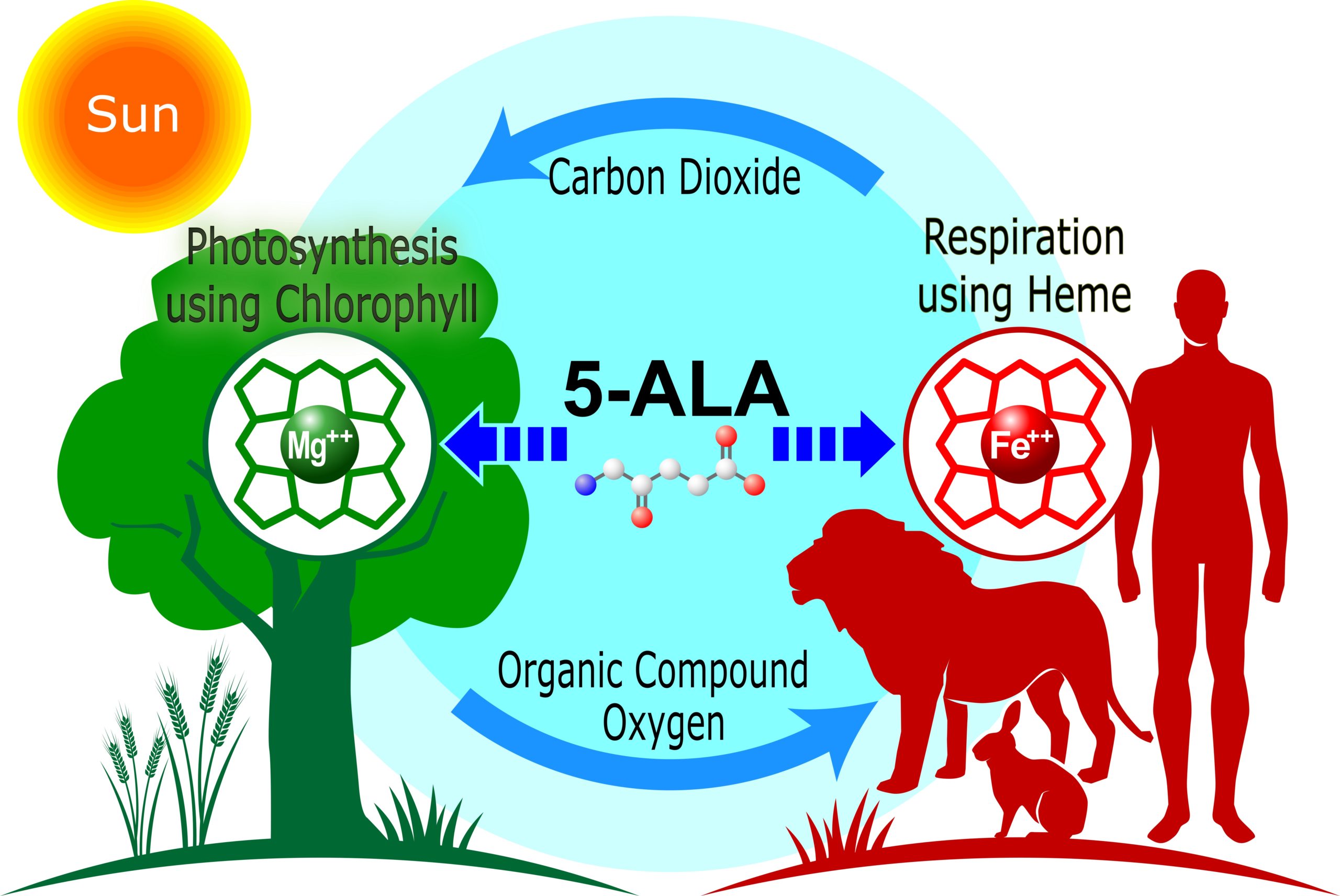
5-ALA stands for 5-aminolevulinic acid. This amino acid is produced ubiquitously by various life forms, such as plants and animals.
5-ALA is close in form to other amino acids such as gamma-aminobutyric acid (GABA) and ornithine, but its origin go back far longer. It can be traced back to a common ancestor of all organisms on the Earth today that existed 3.6 to 4 billion years ago.[1][2]。
There is only one role for 5-ALA in the human body, and that is as a component of a substance called heme (haem). Heme, formed by a combination of eight 5-ALAs, is the key to a number of vital activities.
A familiar example of heme activity is the formation of red pigment (hemoglobin) in the blood, which distributes oxygen throughout the body. Oxygen and heme combine and separate depending on the surrounding environment, and oxygen is delivered from the lungs throughout the entire body.
In addition, heme is the central substance in the respiratory chain complex that produces energy from food and oxygen, which is the basis of our vital activities. Without 5-ALA we would not be able to gain energy or even move.
Chlorophyll, which plays a central role in plant photosynthesis, is also formed by combining eight 5-ALAs, and its structure is very close to heme.
Plants produce oxygen and cells by photosynthesis using light and carbon dioxide. Animals, including humans, consume oxygen and plants and exhale carbon dioxide, and plants grow again using that carbon dioxide. This is the energy cycle of life, which has been in operation since ancient times, and it cannot be achieved without its two axes—heme and chlorophyl— both of which are formed from 5-ALA.
We could even say that 5-ALA is the source of life that shaped the current form of life on Earth.

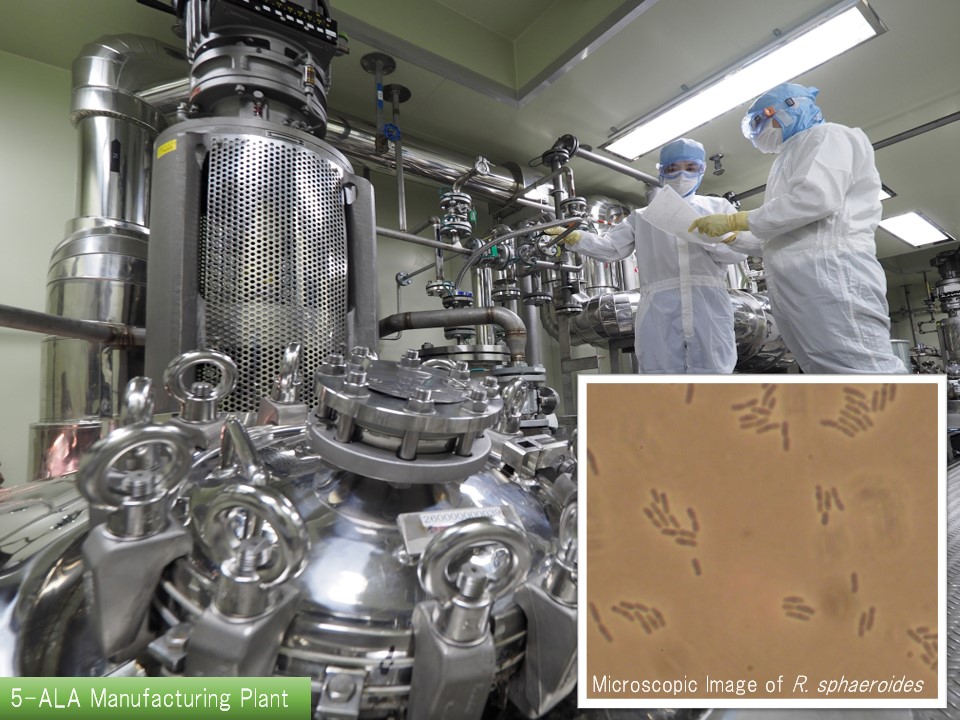
Since the discovery of 5-ALA by the late Dr. David Shemin (Columbia University, U.S.A.) in the 1950s[3], many scientists worked on its basic biology throughout the 20th century. However, chemically synthesizing the 5-ALA used in basic research proved to be extremely complicated, and was more expensive than platinum by weight.
However, as the potential for the medical applications of 5-ALA became evident in the late 20th century, efforts to mass produce 5-ALA increased. Hiroshima University and Cosmo Oil's research team focused on the vigorous 5-ALA-producing ability of Rhodobacter sphaeroides, a photosynthetic microorganism commonly found in rice fields. From the many types of Rhodobacter sphaeroides, the best were repeatedly selected and propagated from countless individual specimens.
Through generations of selection, a strain that had both high 5-ALA production capacity and non-light-requiring properties, and that could be conveniently mass produced and successfully manufactured at the industrial level, was finally realized.
This microbial fermentation method can be widely adopted by anyone as it does not use genetic recombination, and we took over research. Now 5-ALA produced by this method is used in all the pharmaceuticals, health foods and other products produced by SBI Pharmaceuticals.
We continuously work with our partner companies and research institutes to further develop our products and improve our manufacturing technology to ensure that 5-ALA-based products reach more people.
Currently, 5-ALA products made by our company include 5-ALA hydrochloride, used in pharmaceutical products, and 5-ALA phosphate, used in health foods, cosmetics, and animal feed. 5-ALA phosphate used in foods has been registered as an ingredient that can be used as food in the Drug/non-drug list specified by the Ministry of Health, Labour and Welfare (MHLW) of Japan. Our 5-ALA has passed the quality control standards set by the MHLW based on applicable laws. Both pharmaceuticals and health foods have been manufactured to meet the manufacturing standards known as “Good Manufacturing Practice (GMP)” for medicine and “GMP for Dietary Supplements”. Our pharmaceuticals have been available since 2013 and our health foods since 2010.

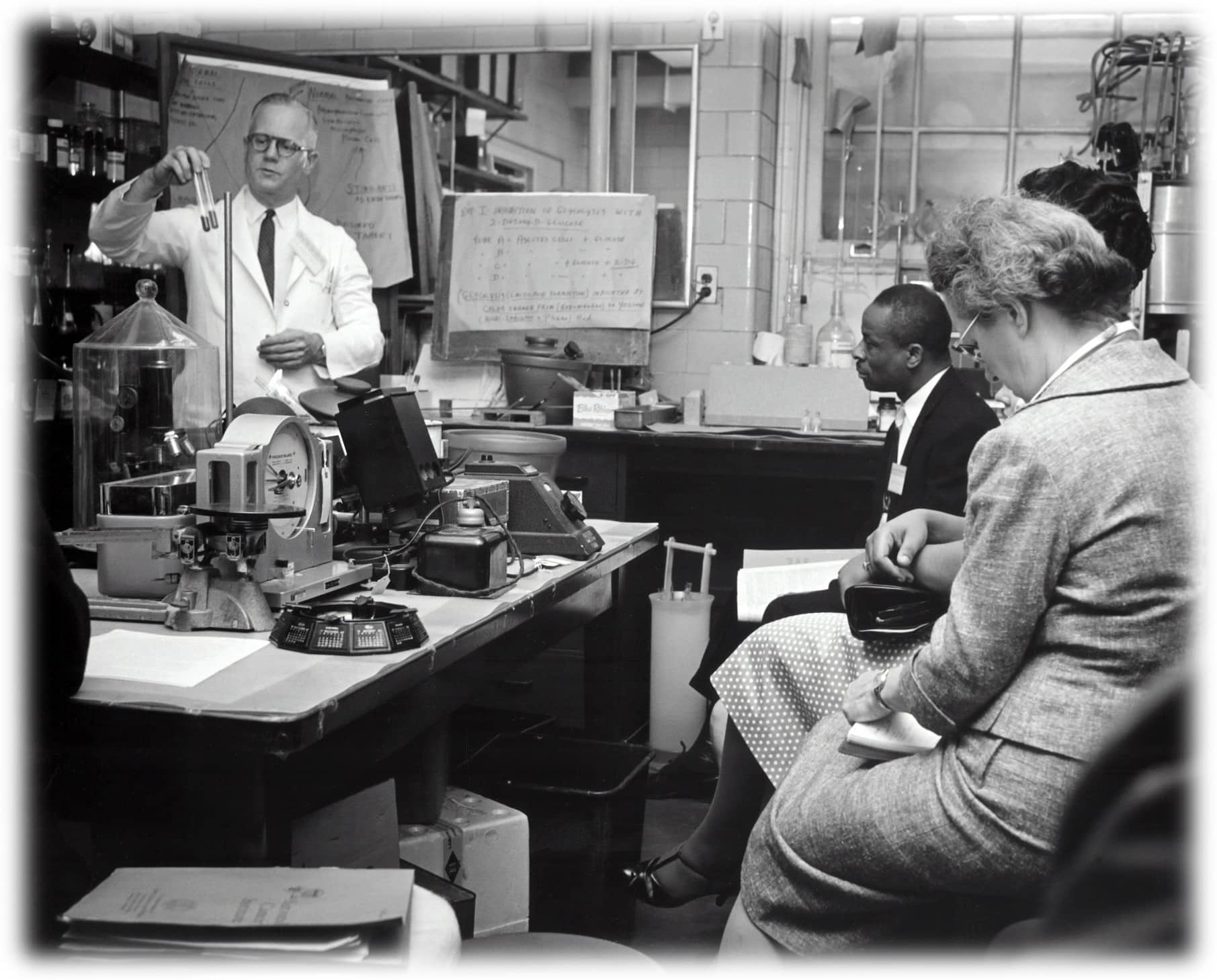
Since the discovery of 5-ALA by the late Dr. David Shemin (Columbia University, U.S.A.) in the 1950s[3], many scientists worked on its basic biology throughout the 20th century. However, chemically synthesizing the 5-ALA used in basic research proved to be extremely complicated, and was more expensive than platinum by weight.
While safe and highly efficient chemical synthesis methods have been pursued, production by microbial fermentation technology has been actively researched in Japan.
The method using the photosynthetic bacterium Rhodobacter sphaeroides, invented by the late Dr. Ken Sasaki (former president of Hiroshima Kokusai Gakuin University), was the first to be put into practical use, and in recent years the micro-organism Corynebacterium glutamicum, which is used to produce MSG umami seasoning, and non-pathogenic E. coli have enabled production with higher efficiency.[4][5]
We continuously work with our partner companies and research institutes to further develop our products and improve our manufacturing technology to ensure that 5-ALA-based products reach more people.
Currently, 5-ALA products made by our company include 5-ALA hydrochloride, used in pharmaceutical products, and 5-ALA phosphate, used in health foods, cosmetics, and animal feed. 5-ALA phosphate used in foods has been registered as an ingredient that can be used as food in the Drug/non-drug list specified by the Ministry of Health, Labour and Welfare (MHLW) of Japan. Our 5-ALA has passed the quality control standards set by the MHLW based on applicable laws. Both pharmaceuticals and health foods have been manufactured to meet the manufacturing standards known as “Good Manufacturing Practice (GMP)” for medicine and “GMP for Dietary Supplements”. Our pharmaceuticals have been available since 2013 and our health foods since 2010.

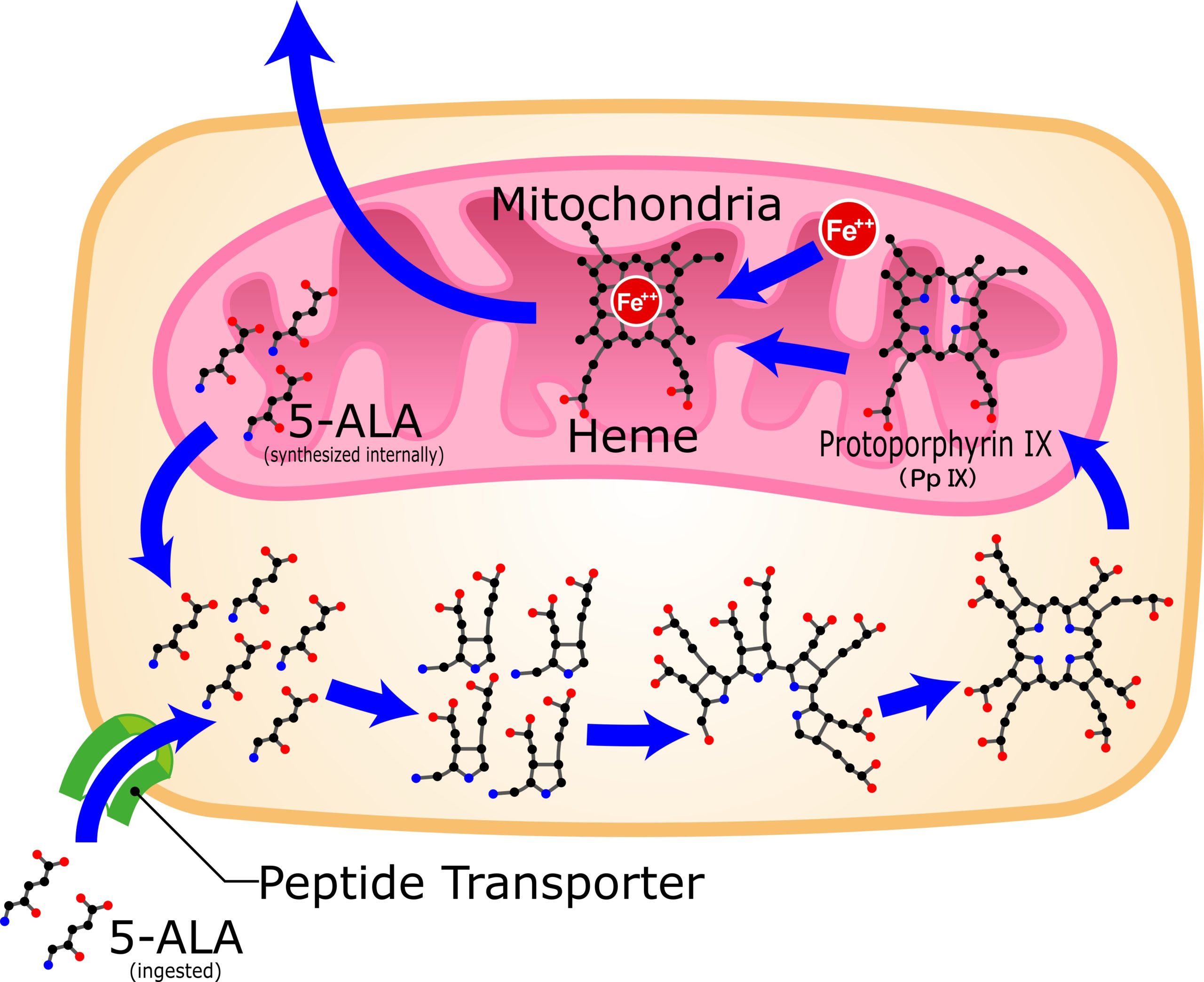 In many cases, simply ingesting a substance that originally exists in the living body will not reach its place of origin or the place where its effects are needed. Just as a car cannot move by spraying gasoline over the rear seats, biological substances cannot function unless supplied in the correct manner.
In many cases, simply ingesting a substance that originally exists in the living body will not reach its place of origin or the place where its effects are needed. Just as a car cannot move by spraying gasoline over the rear seats, biological substances cannot function unless supplied in the correct manner.
However, for 5-ALA, there are two “coincidences” that enable its oral ingestion to exert its original function and change into heme.
The first “coincidence” is that 5-ALA produced in our body is assembled into heme in an unusual way. 5-ALA is created in mitochondria, tiny organs (organelles) inside the cell, but is immediately expelled from the mitochondria. After being assembled almost into its final form outside the mitochondria, it is then reintroduced into the mitochondria, and in the final step it bonds with iron (iron atoms) to complete the heme production (upper figure).It is not clear why such a seemingly inefficient process is employed, but it could be related to the fact that mitochondria once were “parasitic” organisms for us billions of years ago. As they lost their ability to live alone in the course of evolution, they transformed into organelles within us [6].Because our ancestors adopted some of the mitochondria’s heme-producing ability to exploit this enormous energy-producing organism, the middle process of heme assembly may have taken place in “our side,” or outside mitochondria.
The second “coincidence” is the size of 5-ALA. In general, water-soluble substances like 5-ALA cannot pass through cells, but 5-ALA’s structure and size is similar to dipeptide, a two-amino-acid chain produced during the breakdown of protein (food), and can pass through cells using a gate (called transporter) for dipeptides on the cell surface[7].
Due to these two “coincidences,” 5-ALA orally ingested and 5-ALA produced in the body are combined inside the cell/outside the mitochondria and together form heme.
Are these “coincidences” actually a coincidence or are they inevitable? In other words, was this trait for some reason essential in the evolutionary survival race of organisms? Only Mother Nature knows.
Regardless, we are designed to enjoy the blessings of 5-ALA by oral ingestion.

In many cases, simply ingesting a substance that originally exists in the living body will not reach its place of origin or the place where its effects are needed. Just as a car cannot move by spraying gasoline over the rear seats, biological substances cannot function unless supplied in the correct manner.
However, for 5-ALA, there are two “coincidences” that enable its oral ingestion to exert its original function and change into heme.
The first “coincidence” is that 5-ALA produced in our body is assembled into heme in an unusual way. 5-ALA is created in mitochondria, tiny organs (organelles) inside the cell, but is immediately expelled from the mitochondria. After being assembled almost into its final form outside the mitochondria, it is then reintroduced into the mitochondria, and in the final step it bonds with iron (iron atoms) to complete the heme production (upper figure).It is not clear why such a seemingly inefficient process is employed, but it could be related to the fact that mitochondria once were “parasitic” organisms for us billions of years ago. As they lost their ability to live alone in the course of evolution, they transformed into organelles within us [4].Because our ancestors adopted some of the mitochondria’s heme-producing ability to exploit this enormous energy-producing organism, the middle process of heme assembly may have taken place in “our side,” or outside mitochondria.
The second “coincidence” is the size of 5-ALA. In general, water-soluble substances like 5-ALA cannot pass through cells, but 5-ALA’s structure and size is similar to dipeptide, a two-amino-acid chain produced during the breakdown of protein (food), and can pass through cells using a gate (called transporter) for dipeptides on the cell surface[5].
Due to these two “coincidences,” 5-ALA orally ingested and 5-ALA produced in the body are combined inside the cell/outside the mitochondria and together form heme.
Are these “coincidences” actually a coincidence or are they inevitable? In other words, was this trait for some reason essential in the evolutionary survival race of organisms? Only Mother Nature knows.
Regardless, we are designed to enjoy the blessings of 5-ALA by oral ingestion.
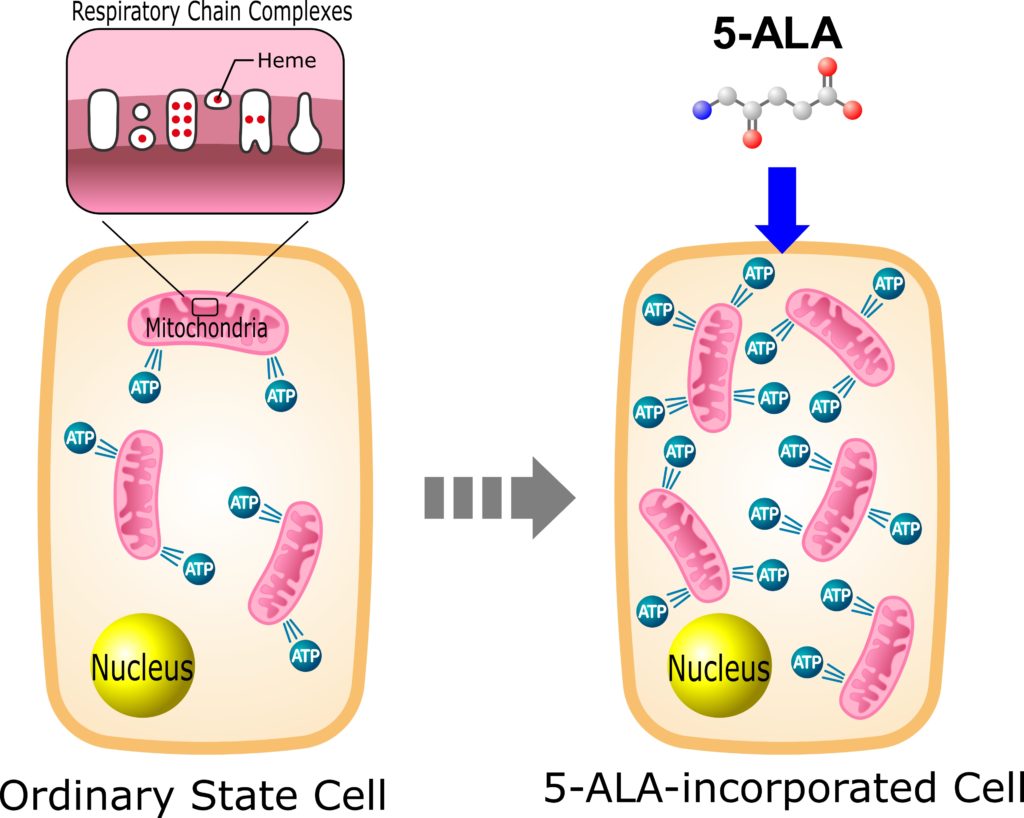 1. Activation and increase of mitochondria
1. Activation and increase of mitochondria* The following articles introduce the results of academic research on 5-ALA in animal experiments, and do not claim to offer a cure for human disease or to prove effective in health foods in humans. Regarding the medical effects of 5-ALA, never decide for yourself and always consult your doctor.
As mentioned above, mitochondria are organelles in the cell that produce 5-ALA, and play the primary role of producing energy from food and oxygen. A “respiratory chain complex” exists in mitochondria, and heme made in mitochondria are taken in situ as the active center of the respiratory chain complex.
We examined the mitochondrial respiratory chain complex in animals given 5-ALA. Surprisingly, we found that its activity—the ability to generate energy—was enhanced[8][9]. The respiratory chain complex functions to convert food-derived energy into electrical energy, producing a substance called adenosine triphosphate (ATP). ATP is used as an energy source in the ubiquitous activities of life. Because ATP can be compared to money in economic activities, ATP is also called the “energy currency for living organisms.” 5-ALA had the effect of increasing this ATP.
In another animal experiment, 5-ALA was found to cause mitochondria to proliferate in cells [10]. This is unusual in that 5-ALA is not increased by increasing mitochondria but vice versa. We are currently exploring the mechanisms behind this.
Mitochondria are a double-edged sword as they are essential, but at the same time, they can mutate to produce substances harmful to living organisms.
Mitochondrial dysfunction and abnormal activities are said to lead to many diseases. We continually work to further understand mitochondrial activity and the proliferative effects of 5-ALA in the application of treatment for these diseases.
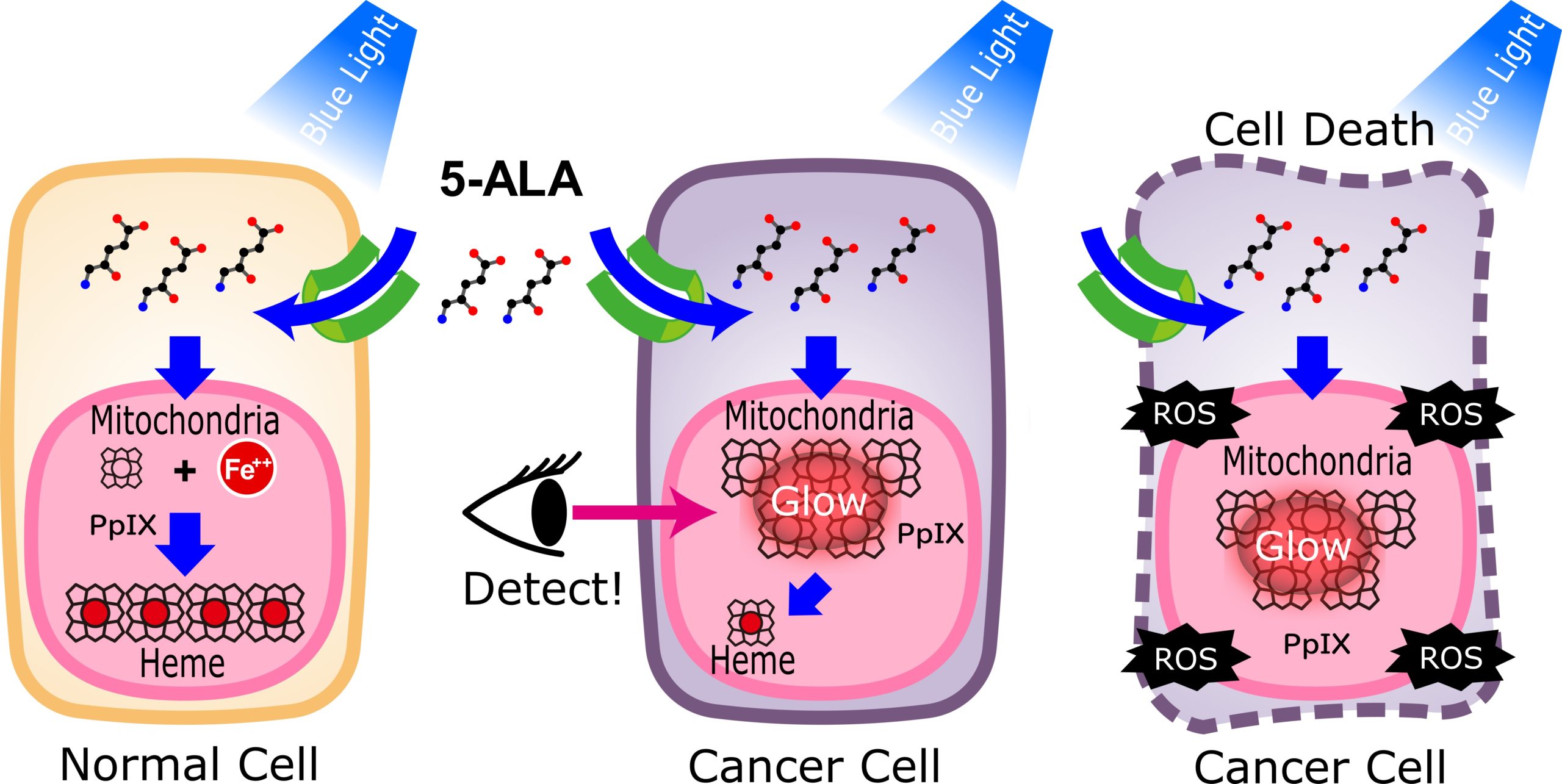 2. Cancer detection and treatment
2. Cancer detection and treatmentHeme generation from 5-ALA is completed by binding iron to a center. A substance called protoporphyrin IX (PpIX) is produced in just one step before iron combination, and it has unique characteristics. When irradiated with blue light of a specific wavelength, it reflects red light.
Cancer cells are ordinary cells that have been transformed by DNA mutation and have acquired the ability to proliferate indefinitely. Cancer cells are also seen to have abnormalities in the heme production mechanism. Cancer cells that have absorbed large amounts of 5-ALA are found to be unable to produce heme properly and accumulate PpIX one step before [11].
From this, it is possible to make only cancer cells glow red using blue light by giving 5-ALA to animals with cancer, since 5-ALA is converted into heme in ordinary cells but remains as PpIX in cancer cells.
This property has been long known and has been confirmed in the clinical field. Many researchers have studied this as a way to detect small cancers that cannot be observed with the naked eye. This method is called photodynamic diagnosis (PDD).
It is also known that when exposed to light, PpIX produces reactive oxygen species (ROS), a substance that is highly toxic to cells. Treatment that uses this phenomena to selectively kill cancer has attracted attention as photodynamic therapy (PDT).
Recently, in order to overcome the weakness of PDT, namely that light does not reach deep inside the body where many types of cancer cells exist, many researchers have been working on releasing ROS from PpIX by various methods such as ultrasound and radiation. We hope that this can be established as a cancer treatment that is completely different from conventional technologies.
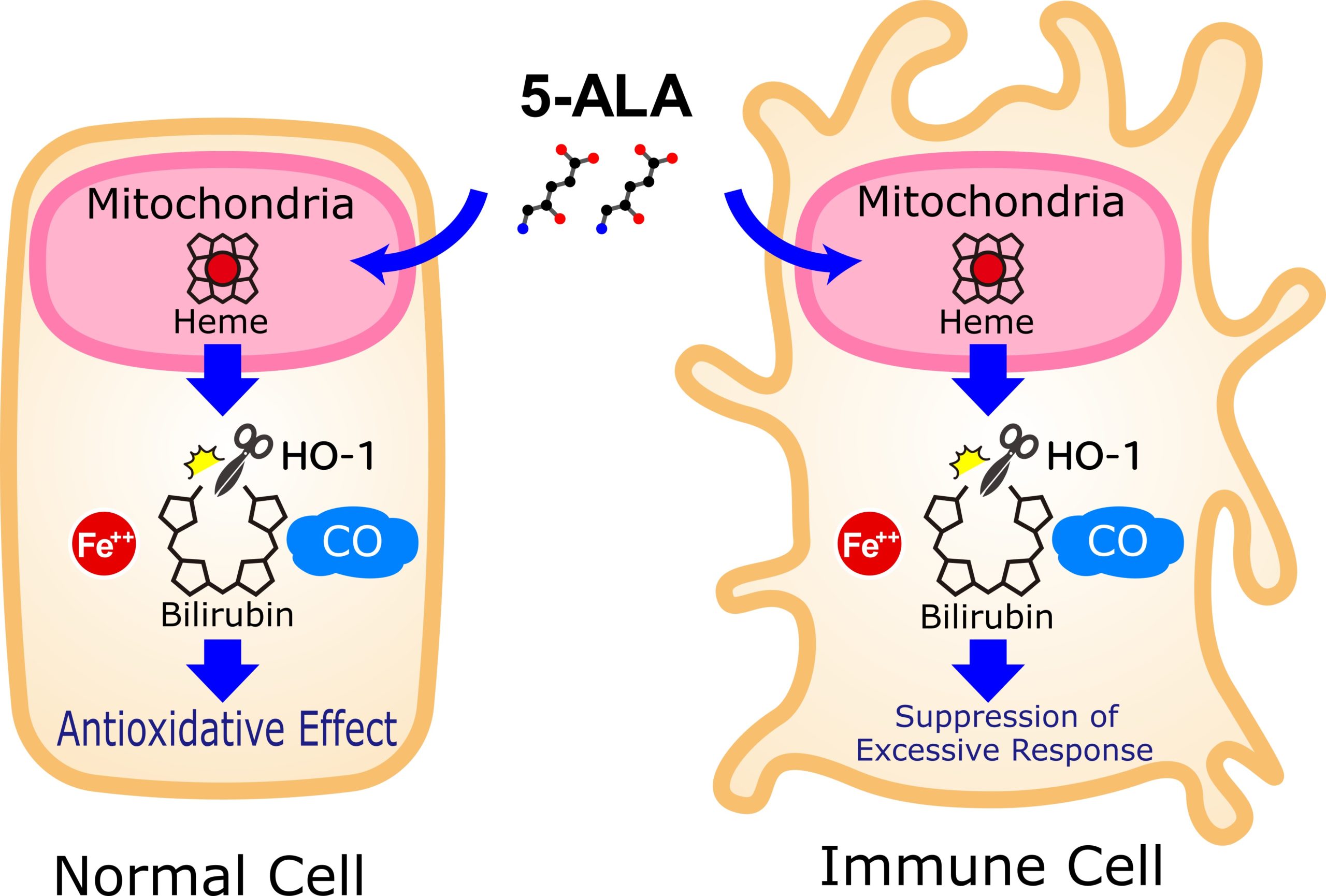 3. Anti-oxidation and immune-modulation by degrading heme
3. Anti-oxidation and immune-modulation by degrading hemeHeme, although having a wide range of functions, is also known to be toxic to living organisms if it produces ROS in areas where it should not. To control this problematic substance, our body creates an enzyme called heme oxygenase-1 (HO-1)
HO-1 breaks down excess heme to maintain a constant amount of heme in the body. Interestingly, bilirubin and carbon monoxide, produced from degraded heme, function to eliminate active oxygen [12].
HO-1 is produced in large quantities when ROS is detected, including ROS due to heme, and this plays a defensive role in the body by degrading heme.
In animals given large doses of 5-ALA, most of it does not remain in the body as heme. Some 5-ALA in the blood was found to be immediately converted into bilirubin by HO-1 via heme [13]. Focusing on this, we found that 5-ALA has a strong antioxidant effect (the effect of eliminating ROS) by inducing HO-1 and producing bilirubin and carbon monoxide [14].
Furthermore, 5-ALA not only has an antioxidant effect, but also a suppressive effect in excessive immune cell reactions that cause harm to the body instead of attacking foreign matter, due to the upregulation of HO-1 in immune cells [15].
Currently, many companies are developing drugs targeting HO-1. We are conducting R&D on 5-ALA as a drug candidate that induces HO-1 while supplying its own substrate heme at the same time.
Referrence